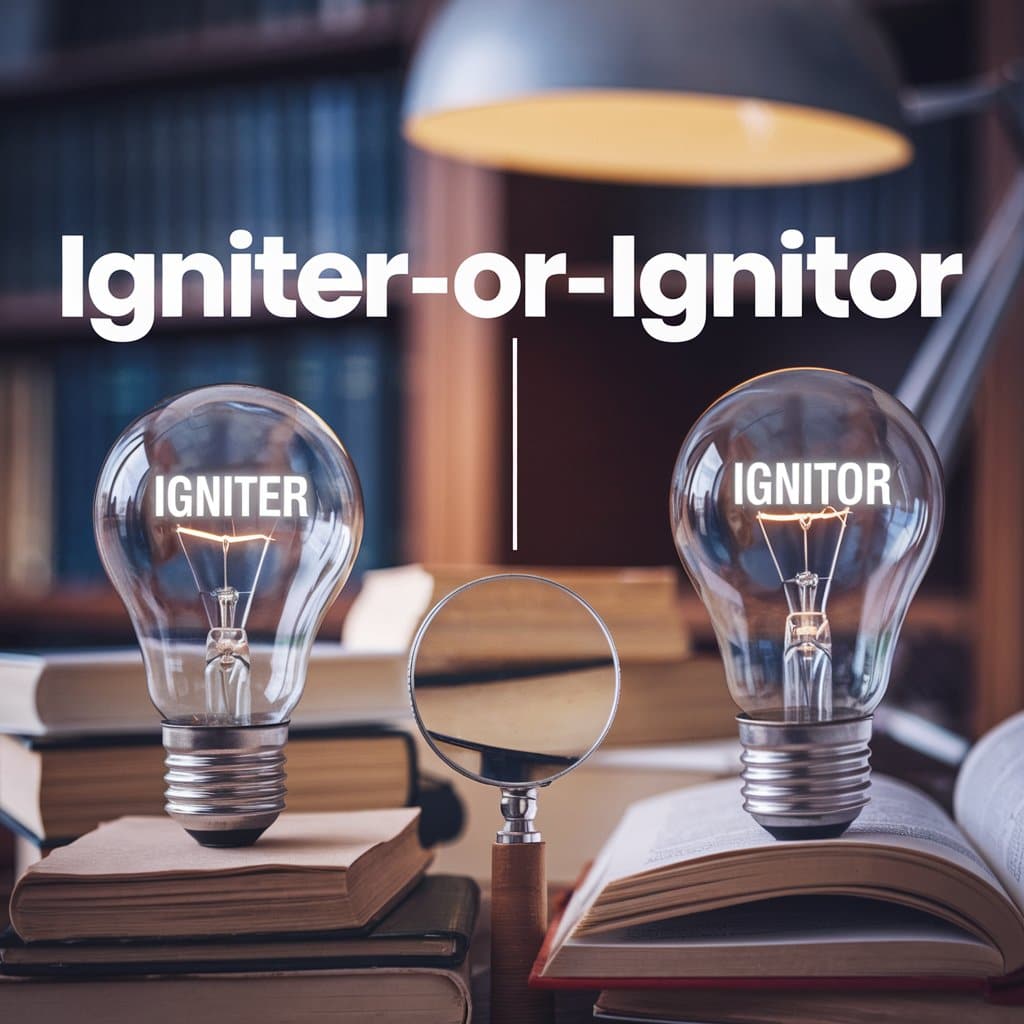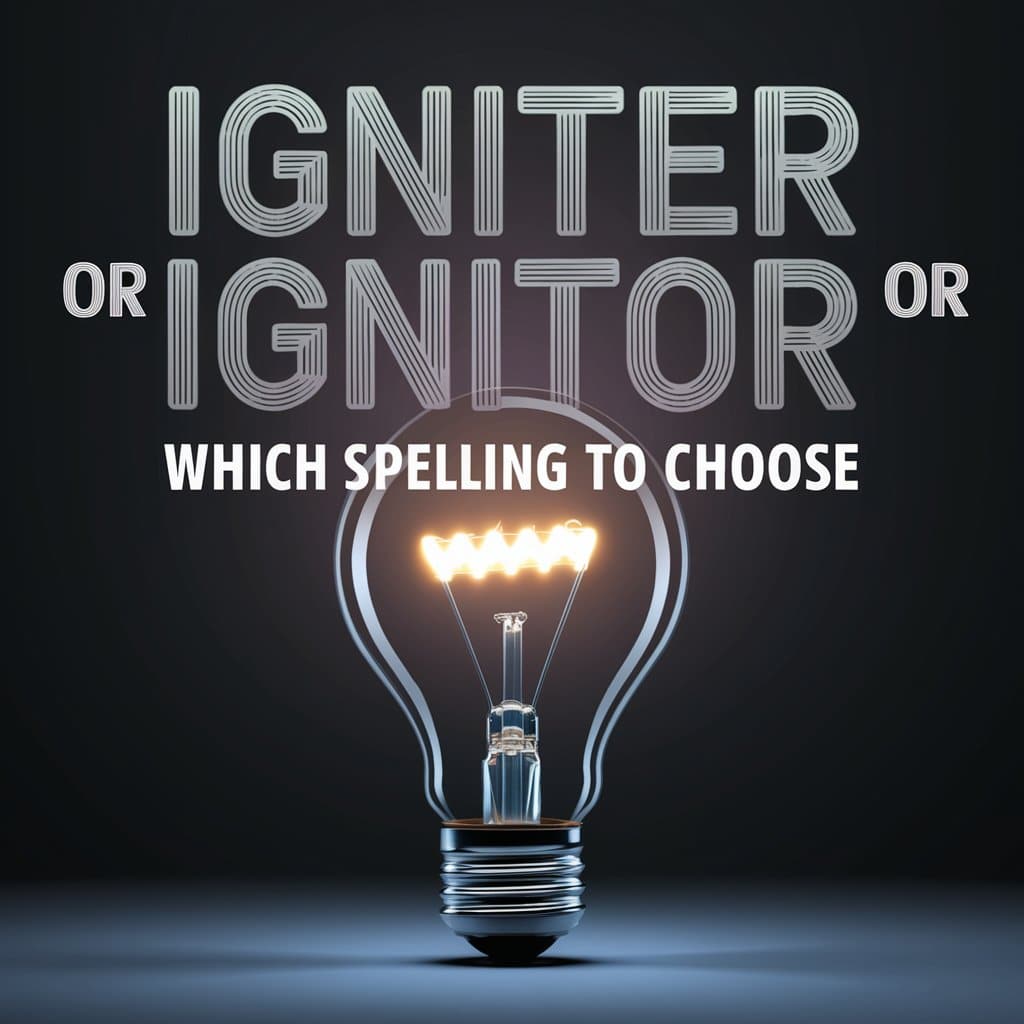When it comes to technical terms like “igniter” or “ignitor”, choosing the right spelling can be confusing. Both variants seem to describe the same thing—a device that initiates combustion—but is one more correct than the other? Does it depend on where you are or what industry you’re in?
This article will dive into the history, meaning, usage, and differences between these two spellings. We’ll also explore synonyms for igniter, examples in context, and guidelines on choosing between terms.
Why Is There Confusion?
The confusion between “igniter” and “ignitor” largely stems from regional spelling preferences and modern spelling conventions. Like other English words with similar suffixes (e.g., “center” vs. “centre”), the variation between American English usage and British English has led to the acceptance of both forms. This divergence can be found in many fields, especially in areas like technical product descriptions, educational materials, and even job titles.
Key Reasons for Confusion:
- Historical Regional Contexts: English as a language has evolved differently in the UK and the US. The “-er” ending (as in “igniter”) is more common in American English, while British English sometimes opts for “-or” (as in “ignitor”). However, British usage has become more aligned with the “-er” spelling in recent times.
- Industry-Specific Preferences: Certain industries, such as aerospace, automotive, and manufacturing, have standardized one form over the other. This variation depends on the manuals or documentation they follow, leading to the usage of one spelling in technical contexts.
- Linguistic Fluidity: The spelling of many English words has changed over time. Some words stabilize in one form, while others, like “igniter” and “ignitor,” continue to coexist without a definitive rule.
In many cases, the spelling you encounter depends on where you are and what resources you’re using. However, understanding these variations can help you choose the right term based on your context.
Meaning and Usage: What Do “Igniter” and “Ignitor” Mean?

Understanding the meanings of “igniter” and “ignitor” goes beyond just defining a word; it involves exploring how these terms are used in various contexts, especially in technical fields. While both terms refer to a device that initiates combustion, they may carry slight nuances depending on the industry or region. Let’s delve deeper into what these terms mean and how they are commonly used.
Definition Breakdown
Igniter:
General Definition: An igniter is a device, tool, or mechanism that produces a spark or flame to start combustion. This could involve igniting fuels in engines, starting fires in stoves, or initiating chemical reactions in various industrial applications.
Common Uses:
- Automotive: In automotive terminology, an igniter is part of the ignition system that creates a spark to ignite the air-fuel mixture in an engine’s cylinder.
- Household Appliances: Igniters are often found in gas stoves and ovens where they light the burner.
- Fire-Starting Tools: Portable igniters, such as lighters or matches, are used for starting fires in everyday situations like camping or grilling.
Ignitor:
General Definition: The term ignitor serves as an alternate spelling of igniter and typically has the same meaning. It refers to any device that causes ignition, but it’s less commonly used in contemporary American English.
Common Uses:
- Technical Literature: You might encounter “ignitor” in older technical documents, manuals, or specific scientific contexts where the term has historical significance.
- Certain Regions: While “ignitor” might be less prevalent today, it may still appear in British English or specialized industries, often reflecting historical regional contexts.
Read more : Axle or Axel: What’s the Difference?
Contextual Applications
The context in which “igniter” and “ignitor” are used can greatly influence their meaning and acceptance:
Automotive Industry
In automotive contexts, the word “igniter” is widely recognized. It is a critical component in an engine’s ignition system. The igniter works alongside spark plugs to ensure that the air-fuel mixture in the combustion chamber ignites at the right moment.
Example Usage:
- “The vehicle’s igniter failed, causing the engine to misfire.”
In contrast, “ignitor” might appear in older texts discussing automotive technology, but it’s becoming increasingly rare.
Aerospace and Engineering
In aerospace and engineering, both terms might be utilized interchangeably. However, “igniter” is the more common choice for describing devices that ignite rocket propellants or other combustible materials.
Example Usage:
- “The rocket’s igniter is crucial for initiating the combustion of the fuel.”
Everyday Language
In everyday language, “igniter” is the preferred term. It covers a range of applications, from matches and lighters to more complex devices in industrial machinery.
Example Usage:
- “Always carry a reliable igniter when camping to ensure you can start a fire.”
Conversely, “ignitor” might be encountered in niche discussions or older literature.
Nuances and Preferences
The preference for “igniter” over “ignitor” in modern contexts stems from the influence of American English. As language evolves, certain terms gain popularity based on their frequency of use in education, manuals, and the marketplace.
- Industry Standards: Many industries have established guidelines that favor “igniter,” ensuring consistency in technical communication. This standardization is especially vital in fields like automotive and aerospace, where precision in terminology can impact safety and functionality.
- Perception: Using “igniter” often conveys a more contemporary understanding of the term, while “ignitor” may suggest a dated approach or older documents. For most writers and professionals today, sticking with “igniter” is the safe choice.
Examples of Use:
- In aerospace engineering, an igniter may refer to a small device that helps initiate the combustion process in rocket engines.
- In automotive ignition systems, an igniter is a key part of the mechanism that starts a vehicle’s engine by creating a spark.
- In fire-starting tools, such as lighters or fire pistons, “igniter” is often the term used in marketing or product descriptions.
While the meanings are essentially identical, the choice of spelling depends on factors like industry norms, audience, and regional spelling preferences.
You may also like : Lead or LEED: When to Use Which One?
Which Spelling Should You Use?
Regional Preferences
When deciding whether to use igniter or ignitor, the most important consideration is where your audience is located. American English usage typically favors the spelling “igniter,” while the “ignitor” variant, though less common, might appear in some British English or specialized technical contexts.
- In the U.S., “igniter” is almost universally accepted and used across different industries and regions.
- In the U.K., while “ignitor” may occasionally pop up, especially in older texts, “igniter” has become the preferred spelling in modern usage. This reflects modern spelling conventions in British English, which have shifted towards the “-er” form.
Industry Standards
Certain industries also dictate which spelling is used. Technical documentation, in particular, can differ from everyday language. Here’s a breakdown of some industries:
| Industry | Preferred Spelling | Examples |
| Automotive | Igniter | “Igniter” is commonly used in automotive ignition systems and manuals. |
| Aerospace | Igniter | Aerospace firms generally standardize on “igniter” in their technical documents. |
| Manufacturing | Igniter | Most manufacturing companies opt for “igniter” in their product descriptions. |
| General UK Usage | Igniter | “Igniter” is now the common spelling in British English for everyday use. |
| Older British Texts | Ignitor | “Ignitor” may still appear in some historical texts, though it’s becoming rare. |
Standardization
In formal technical documentation, like SAE standards or IEEE guidelines, the term “igniter” is the more commonly accepted form. For instance, an SAE (Society of Automotive Engineers) manual on automotive ignition systems will typically use “igniter,” aligning with broader industry standards.
A General Rule of Thumb:
If you’re writing for a U.S. audience or any industry that follows modern spelling conventions, “igniter” is the safer choice. If you’re dealing with historical documents or specialized fields that lean toward British conventions, “ignitor” might still be appropriate—but even then, it’s becoming less common.
Synonyms and Related Words
If you’re looking to diversify your vocabulary or avoid repetition, there are several synonyms for igniter that can be used depending on the context.
Common Synonyms for Igniter:
- Spark plug: Specifically used in engines to create the spark that ignites the fuel.
- Lighter: A tool used for creating a flame, often for cigarettes or starting fires.
- Firestarter: A general term for devices used to initiate a fire, like matches or ferro rods.
- Catalyst: In a figurative sense, a “catalyst” can also refer to something that causes a reaction or event to begin.
- Flint: A stone used in traditional fire-starting methods.
Use Cases:
- Spark plugs are found in automotive ignition systems and are a critical part of engine functionality.
- Lighters and firestarters are common in camping gear and emergency kits.
- The word catalyst might be used more figuratively but serves as a useful synonym in a broad range of contexts.
By incorporating these synonyms, you can keep your writing dynamic while maintaining clarity. This variety also helps when creating technical product descriptions, especially when explaining different kinds of fire-starting tools.
Real-World Usage: Examples in Context
Understanding how both “igniter” and “ignitor” are used in the real world can provide valuable insight into which form is more appropriate. Below are a few examples in context across different industries and regions.
Example 1: Automotive Manuals
In automotive ignition systems, the term “igniter” is widely used. For example, an owner’s manual for a Toyota Corolla describes the igniter as a crucial part of the engine’s ignition system. This use is consistent across many manufacturers in the auto industry.
Example 2: Aerospace
In aerospace engineering, documentation from companies like SpaceX or Boeing consistently uses “igniter” when describing parts of rocket engines or systems designed to initiate combustion.
Example 3: Historical Texts
In older British texts, you might find “ignitor” used more frequently. For example, in an early 20th-century handbook on steam engines, the term “ignitor” is employed to describe the mechanism that starts the combustion process. Today, however, even technical fields in the UK have mostly transitioned to “igniter.”
Usage in Product Descriptions
Retail websites or technical product catalogs often use “igniter” when describing fire-starting tools, like lighters, matches, or camping gear. “Ignitor” is rarely seen in modern product descriptions, regardless of the region.
By analyzing these examples, it’s clear that “igniter” has become the dominant spelling in both general and technical use.
Must read this article : Backward or Backwards: Which is Correct?
Origins of the Word: Etymology and Evolution
The words “igniter” and “ignitor” share the same origin, tracing back to the Latin word “ignis,” meaning fire. This root word is the basis for several fire-related terms, including ignite, ignition, and even the more figurative use of ignite (as in sparking interest or excitement).
The Evolution of the Spellings
- The Latin word “ignis” evolved into the English word “ignite” in the 17th century, with “igniter” and “ignitor” following as nouns derived from this verb.
- As English spread across regions, especially to America, the standard spelling shifted to “igniter” in most regions, while “ignitor” became less common but persisted in some British contexts.
The -er vs. -or debate reflects broader patterns in English, where many words have evolved multiple spellings due to regional influences. Examples include “theater” vs. “theatre” or “analyzer” vs. “analyser.”
Conclusion
Ultimately, choosing between “igniter” or “ignitor” depends on your audience, region, and the industry you’re addressing. In most cases, especially for American English usage and modern technical standards, “igniter” is the preferred spelling. However, “ignitor” may still appear in specific historical contexts or older British texts.
When in doubt, consult your regional spelling preferences or industry guidelines, and remember that both terms convey the same meaning: a device that initiates combustion. For additional clarity, you can also use synonyms for igniter like “spark plug” or “firestarter” when appropriate.
Understanding the nuances between these spellings will help you communicate more effectively, whether you’re writing a technical manual, describing fire-starting tools, or just trying to settle a spelling debate.

John David is an experienced blogger at Grammar Blend, passionate about language and communication. With a keen eye for grammar and clarity, he shares practical tips and tools to help readers improve their writing skills. His insightful articles make grammar accessible and engaging for learners of all levels.







